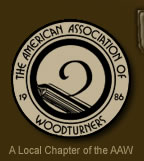Several Club members are available to serve as mentors in their specific areas of ineterest.
Introductory Turning
Cliff Baker, Dave Vehrs, and Bill Sproul are often available for introductory turning instruction at at the Turning Center at Lee Street. where the Club maintains a number of lathes. If you're new to turning or haven't got a lathe yet but need help with specific skills, send Bill an email to arrange a schedule.
Thin Natural Edge Bowls
Mike Cope frequently turns thin natural edge bowls using green wood. He likes to use green wood because it distorts as it dries and adds a new element to the design. He sands the bowl before it is completely dry so that when it dries, the surface becomes slightly textured where there are complex grain patterns. Email Mikefor further information.
Pens and Bottle Stoppers
In addition to turning larger objects, Bob Nickell turns a wide variety of pens, bottle stoppers and other small items using everything from native woods to brass shell casings. Email Bob for further information.
Spindle Turning
Bill Sproul often turns legs for furniture projects with the result that he has a lot of experience using a skew chisel to turn duplicate spindles. Bill also has many suggestions for applying a perfect finish to turned objects. Email Bill for further information.
Segmented Turning
Jim Meyer often turns segmented objects and is available to help other Club members learn how to design segmented turnings, cut and assemble the individual segments, and carry out the turning. Because of the saws, sanders, jigs and clamps necessary to prepare the segmented blanks, mentoring sessions take place in his shop in Athens. Email Jim for further information.
Natural Edge Bowls and Unusual Wood
Cliff Baker enjoys turning natural edge bowls and also vases and bowls made from unusual pieces of wood. Many turners are reluctant to use wood with knot holes, rotten areas, cracks, and branches, but they often yield very unusual and beautful objects. The wood also challenges the turner to imagine what the wood might hold, how to best utilize the features of the wood, how to lay out the blank, and how to chuck it securely so the piece may be turned safely. Email Cliff for further information.
by WVWA, a chapter of the American Association of WoodturnersReturn to the home page

